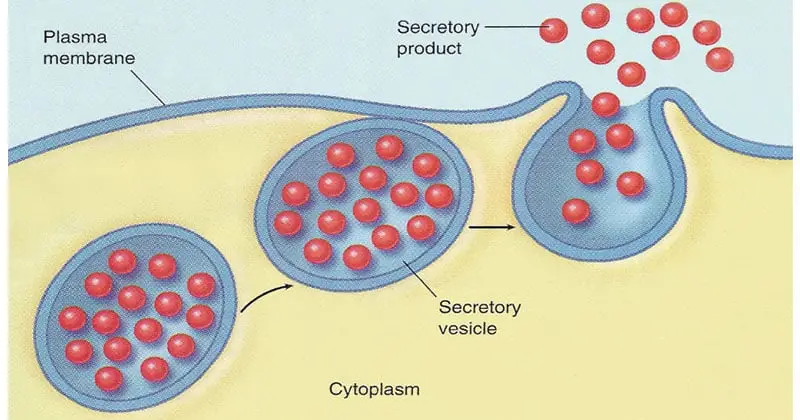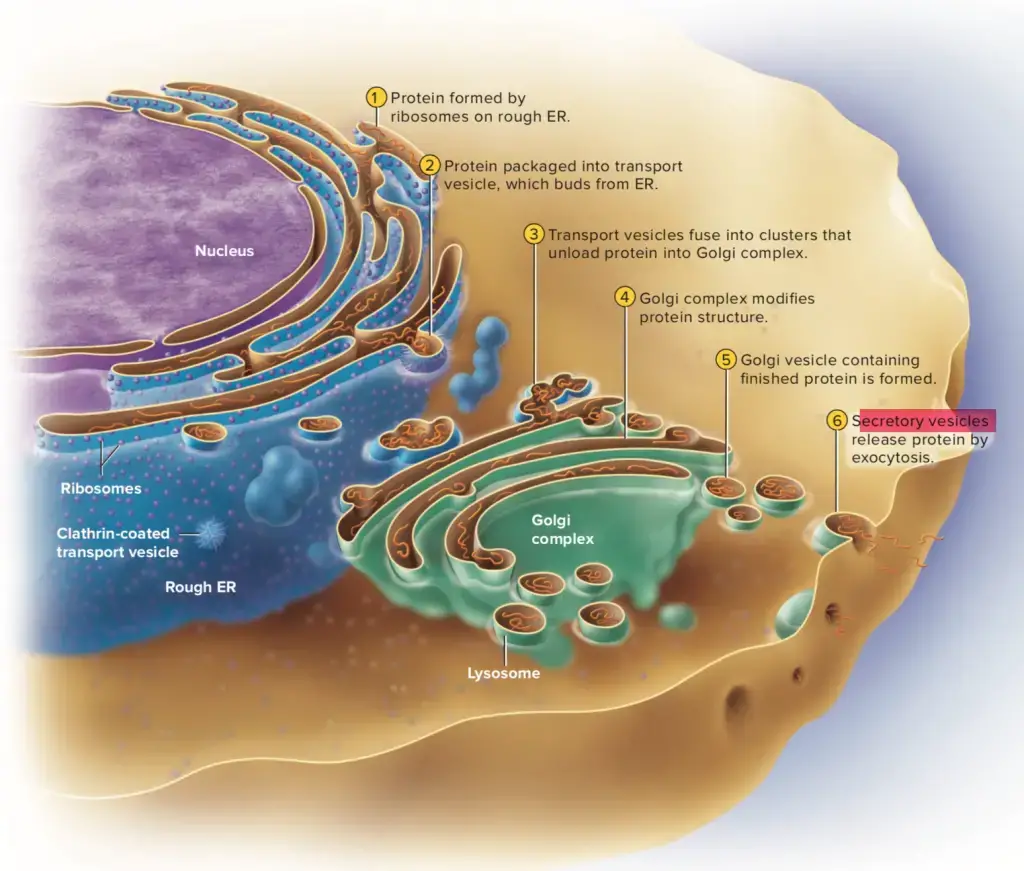What are Secretory Vesicles? – Definition of Secretory Vesicles
- The transport and secretion of proteins, lipids, and other molecules is facilitated by secretory vesicles, which are membrane-bound organelles unique to eukaryotic cells. Microtubules or actin filaments carry these vesicles from their formation sites in the ER and Golgi apparatus to the cell membrane and other locations in the cell.
- The secretion of hormones, neurotransmitters, digestive enzymes, and other crucial chemicals highlights the significance of secretory vesicles in many fundamental cellular activities. Moreover, they are engaged in the cellular response to diverse environmental signals and in the regulation of cell proliferation and differentiation.
- With the discovery of cellular secretion in the 19th century, scientists have been interested in studying secretory vesicles. Secretory vesicle shape and function were studied in more depth in the 20th century thanks to developments in microscopy and cell biology.
- The discovery of the Golgi apparatus by Camillo Golgi in the late 19th century was a major step forward in understanding the process by which proteins and other molecules are synthesised in the ER, transported to the Golgi, sorted and modified, and then transported to their final destination in secretory vesicles.
- The finding of secretory vesicles in the release of neurotransmitters by Bernard Katz and his coworkers in the middle of the twentieth century was another significant discovery. Secretory vesicles fuse with the plasma membrane and their contents are released through a process called exocytosis, which was discovered as a result of these studies.
- A vast variety of biological processes, such as cell communication, immunological responses, and disease states, have been elucidated because to ongoing study on secretory vesicles.

Types of Secretory Vesicles
There are present two types of Secretory Vesicles such as;
1. Synaptic Vesicles
- At the neuron’s presynaptic terminals are small vesicles that play a role in the storage of neurotransmitters.
- After the signal reaches the axon terminal, the vesicles containing the neurotransmitter fuse with the cell membrane and are released.
- The fusing of these two cells generates a synaptic connection, through which neurotransmitters can enter the receiving cell and attach to a receptor.
Working of Synaptic Vesicles:7
- Secretory vesicles respond to a hormonal or neurological signal by releasing proteins or other substances.
- The vesicle membrane can fuse with the target cell membrane to release its contents.
- After the vesicle membrane has been introduced to the target cell, the contents are released.
- This membrane development is usually transient, lasting only until another vesicle is formed in the target cell to expel the contents.7
Example of Synaptic Vesicles:
Impulses cause the membrane at the nerve terminal of the nerve cell to fuse with the secretory vesicles. A gap forms between the nerve ends, called the synaptic cleft, allowing neurotransmitters to be released. The proteins and glycoproteins are secreted to the outside of the cell after the vesicle membrane fuses with the cell membrane. Exocytosis is the common name for this process. After the components are re-obtained via endocytosis, the cell membrane area returns to normal because of the fusion.7
2. Vesicles in Endocrine Tissues
- Several of the cells in the endocrine tissues have a role in the production of substances like hormones. The other cells can’t function without these hormones.
- Hormones are released into the bloodstream from secretory vesicles when they are needed.7
- It is the job of endocrine tissues to secrete hormones into the bloodstream, where they can reach and govern cells and organs far away. Hormones are secreted from endocrine cells, and vesicles play a crucial role in this process.
- When an endocrine cell detects a certain signal or stimulus, it will release hormones that have been stored in controlled secretory vesicles. These vesicles, which are enclosed by a single lipid bilayer, are typically found in the cytoplasm close to the plasma membrane.
- The hormone is secreted into the bloodstream when vesicles containing the hormone fuse with the plasma membrane in response to a signal. Protein interactions between the vesicle membrane, plasma membrane, and cytoskeleton mediate this process.
- Secretory vesicles in endocrine tissues can range in size and content according to the hormone being manufactured. When compared to vesicles found in other endocrine cells, those found in pancreatic beta cells, which make insulin, are larger and contain higher quantities of insulin.
- Disruption of vesicle-mediated secretion can lead to a variety of endocrine illnesses and diseases, therefore it’s clear that vesicles play a crucial function in endocrine tissues.

Functions of Secretory Vesicles
The secretion of many different biomolecules, such as hormones, neurotransmitters, enzymes, and growth factors, is dependent on the function of membrane-bound compartments called secretory vesicles. The secretory vesicle performs a number of crucial roles, including the following.
- Storage of biomolecules: Organelles for storing biomolecules that are created by the cell but are not immediately required for cellular function are called secretory vesicles. When a signal or stimulus is received, the cell can quickly release these molecules.
- Regulation of secretion: Secretion is controlled by a variety of intracellular and extracellular signals, and the release of biomolecules from secretory vesicles is strictly regulated. The release of certain molecules at specific times and in specific amounts is therefore ensured.
- Facilitation of intercellular communication: Because many secretory vesicles, such neurotransmitters and hormones, contain biomolecules that are crucial for intercellular communication, they play a key role in facilitating this process. Cells are able to coordinate their functions thanks to the release of these molecules, which facilitate communication between them.
- Recycling of cellular waste: Lysosomes are a class of secretory vesicle that contain hydrolytic enzymes needed to degrade and recycle waste products from cells. This aids in preventing toxic buildup within cells and keeping homeostasis stable.
- Protection against pathogens: Certain secretory vesicles, including those produced by immune cells, include chemicals critical to the body’s defence against infections. Certain immune cells, for instance, use secretory vesicles to produce antimicrobial peptides that kill invading bacteria and viruses.
Secretory vesicles play a wide variety of roles that are crucial to the health of cells and organisms. Diseases and disorders involving the endocrine system, the nervous system, and the immunological system can all be caused by problems with vesicle-mediated secretion.
FAQ
What are secretory vesicles?
Secretory vesicles are membrane-bound organelles that store and transport molecules such as hormones, enzymes, and neurotransmitters to be released from the cell.
What do secretory vesicles contain?
Secretory vesicles can contain a variety of molecules, including hormones, enzymes, and neurotransmitters.
How are secretory vesicles formed?
Secretory vesicles are formed by a process called budding, in which a portion of the cell membrane pinches off to create a small, spherical vesicle.
Where are secretory vesicles found?
Secretory vesicles are found in many different types of cells, including endocrine cells, nerve cells, and immune cells.
What is the role of secretory vesicles in the endocrine system?
Secretory vesicles play a critical role in the endocrine system by storing and releasing hormones into the bloodstream.
What is the role of secretory vesicles in the nervous system?
In the nervous system, secretory vesicles are responsible for storing and releasing neurotransmitters, which are critical for communication between neurons.
How do secretory vesicles release their contents?
Secretory vesicles release their contents by fusing with the cell membrane and releasing their cargo outside of the cell.
What happens if there is a problem with secretory vesicles?
Problems with secretory vesicles can lead to a range of health issues, including endocrine disorders, neurological disorders, and immune disorders.
How are secretory vesicles studied?
Scientists study secretory vesicles using a variety of techniques, including electron microscopy, fluorescent labeling, and genetic manipulation.
What is the potential for therapeutic interventions targeting secretory vesicles?
Therapeutic interventions that target secretory vesicles have the potential to treat a wide range of diseases, including diabetes, Parkinson’s disease, and autoimmune disorders.
References
- https://www.ncbi.nlm.nih.gov/books/NBK9886
- https://www.ck12.org/biology/Vesicles-and-Vacuoles/lesson/Vesicles-and-Vacuoles-Advanced-BIO-ADV/
- https://study.com/academy/lesson/vesicles-definition-function-quiz.html
- https://bio.libretexts.org/TextMaps/Introductory_and_General_Biology/Book%3A_General_Biology_(Boundless)/4%3A_Cell_Structure/4.4%3A_The_Endomembrane_System_and_Proteins/4.4A%3A_Vesicles_and_Vacuoles
- https://www.abcore.com/secretory-vesicles
- https://courses.lumenlearning.com/boundless-biology/chapter/the-endomembrane-system-and-proteins/
- https://www.vedantu.com/biology/secretory-vesicles
- https://biologywise.com/vesicle-function
- https://www.sciencedirect.com/topics/neuroscience/secretory-vesicles
- Text Highlighting: Select any text in the post content to highlight it
- Text Annotation: Select text and add comments with annotations
- Comment Management: Edit or delete your own comments
- Highlight Management: Remove your own highlights
How to use: Simply select any text in the post content above, and you'll see annotation options. Login here or create an account to get started.